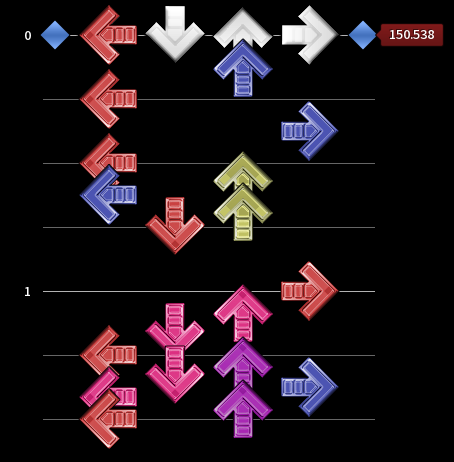
Note value is a term in music theory that refers to the length of time a note is played in relation to the measure. There are quarter notes, eighth notes, sixteenth notes, and so on. In ITG, the notes are colored according to their timing. Note that arrow color depends on where the note falls in relation to the beat, not strictly the duration like in music notation.
¶ Most common note values
¶ Quarter note (4th)
Quarter notes are colored red and fall on the beat of the music. This is the numbers when counting music, 1 & 2 & 3 & 4 &.
¶ Eighth note (8th)
Eighth notes are colored blue and fall on the offbeat. This is the "and" when counting music, 1 & 2 & 3 & 4 &.
¶ Twelfth Note (12th)
Twelfth notes are usually colored purple or sometimes green. They can represent a few different things in music: 8th-note triplets, compound (3-based) time signatures such as 6/8, and swung rhythms.
¶ Sixteenth note (16th)
Sixteenth notes are usually yellow, sometimes green. These represent notes that fall on a 16th note, the "e" or "a" in counting music. A stream of sixteenth notes goes red-yellow-blue-yellow. Sixteenth notes are twice as fast as 8th notes.
¶ Twenty-fourth note (24th)
24th notes are usually colored some shade of purple which can be different from 12ths. They can represent a few different things in music: 16th-note triplets, compound (3-based) time signatures such as 6/8, and fast swung rhythms.
¶ Thirty-second note (32nd)
32nd notes are orange in some ITG noteskins, but can be other colors. These represent notes that fall between two 16th notes. 32nd notes are twice as fast as 16th notes.
¶ Rare Note Values
¶ Forty-eighth note (48th)
48th notes can be various colors. They can represent things like bursts in slowdowns and precise rhythms. They are also called 32nd note triplets in music.
¶ Sixty-fourth note (64th)
64nd notes are teal in some ITG noteskins, but can be other colors. These represent notes that fall between two 32nd notes. 64th notes are twice as fast as 32nd notes. They can represent 64th swing.
¶ Twentieth note (20th)
A 20th note represents a quintuplet in music. Sometimes they are used if 24th notes would be too difficult.
¶ 96th and 192nd notes
These are usually used for precise rhythms.